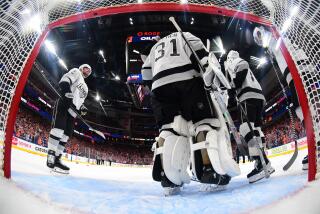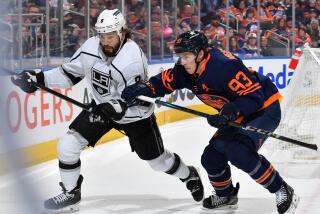Low-Flying Blackhawks Took Wing : After Early Loss to Oilers, Chicago Turned Season Around
CHICAGO — The jeering could be heard throughout the cavernous Chicago Stadium.
A sellout crowd of Chicago Blackhawks’ fans had just seen the defending champion Edmonton Oilers blitz to a 6-0 lead early in their game on Dec. 11. The boos were clearly a sign of frustration for hopeful Hawks’ fans.
But midway through that contest, the Hawks caught fire. They closed the gap to 7-5 before eventually falling in a 12-9 slugfest. It was the Hawks’ fourth straight loss but may have been a turning point in the 1985-86 season.
“When we came back like that, we knew we could come back against anyone,” defenseman Doug Wilson said.
Chicago did lose its next game, 6-3 at Montreal, but the Hawks then took flight. For a two-month stretch, Chicago overtook St. Louis in the Norris Division, did not lose back-to-back games and ended long droughts in such places as the New Yorkl Islanders’ home at the Nassau Coliseum, Buffalo and Washington’s Capital Centre in Landover, Md.
Clearly, the Hawks were playing confident hockey.
“I think confidence is the key word,” Coach-General Manager Bob Pulford said. “This team knows now that when they take the ice they are capable of beating anyone. You can really sense it the way the club has been skating and checking since December.”
The Hawks took the Oilers into a sixth game of last year’s conference championship before falling to the Edmonton juggernaut. Chicago played inspired hockey and gave the Stanley Cup champions a more difficult time than the experts had figured.
The momentum from the playoffs was expected to carry over into the 1985-86 season. But the Hawks, plagued by a leaky defense, shaky goaltending and occasional key injuries, got off to a dismal start. They lost their first three games, dropped four in a row in the start of November and suffered through the five-game losing skein that included the 12-9 contest against Edmonton.
But Pulford started to plug the leaks. He acquired veteran Bob Sauve from Buffalo to replace untested Warren Skorodenski as Murray Bannerman’s backup in the net. Sauve was so steady he earned alternating playing time with Bannerman rather than serving as an occasional backup. He also had a better won-lost record and goals against average than Bannerman, who was an All-Star the last two seasons.
Pulford also gave additional ice time to the high-scoring line of Denis Savard, Al Secord and Steve Larmer. The “SSL” line caught fire about the time of the Edmonton shootout and helped overcome some lingering defensive weaknesses in the Hawks’ attack.
“We had a lot of road games to start off with and that, along with the injuries, may have been the reason we didn’t start off so good,” said Savard, who gave up his post-game cigarettes and was among the top 10 in scoring all season. “This is a team that is ready for the playoffs.”
Additionally, Troy Murray exploded on offense, especially during the Hawks’ troublesome start, and was approaching the 50-goal mark virtually unnoticed.
“He could be a key in the playoffs,” Pulford admits.
More to Read
Go beyond the scoreboard
Get the latest on L.A.'s teams in the daily Sports Report newsletter.
You may occasionally receive promotional content from the Los Angeles Times.






